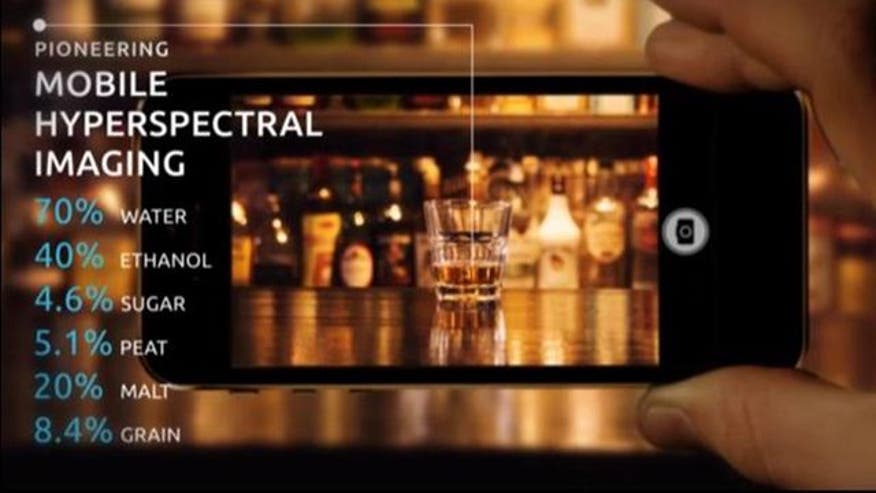
In two months, new technology could turn your smartphone into a “Star Trek”-style Tricorder – making the stuff of science fiction a reality.
This tech, soon to be revealed in Israel, works with your phone to scan any object and reveal its chemical composition.
In “Star Trek”, Starfleet personnel famously use a handheld scanning device called the Tricorder.
One “Star Trek” Tricorder focused on providing remote engineering analysis, while another focused on medical applications.
One would-be Tricorder is being introduced by Unispectral Technologies and Tel Aviv University Ramot, the university’s IP commercialization wing.
The project aims to take the camera filter and software technology from prototype to mass distribution.
According to the company, the tech also improves resolution fourfold and enhances and provides a twofold improvement in low light performance compared to standard smartphone cameras.
But the real buzz is how it gives the humble smartphone “Star Trek”- style hyperspectral detection capabilities.
Every object you could think of has its own unique chemical fingerprint called a hyperspectral signature. The Unispectral tech goes Tricorder by analyzing this signature remotely.
Simple to implement and compatible with all designs, the company says it can transform any smartphone and give it “Star Trek”-style Tricorder powers.
How does it work?
Ordinarily, if you want to work out what the chemical components of something, then you need to physically analyze it. But with this technology, you could point your phone at almost any object and it will reveal its composition.
The system, which comprises an optical lens and image processing software, would be added to your smartphone, giving it Tricorder capabilities.
It allows your ordinary smartphone camera to collect an object’s hyperspectral image.
Hyperspectral imaging picks up and processes information from across the electromagnetic spectrum – far more than cameras that pick up just a few different spectral bands. By doing so, it reveals the chemical composition.
The data from the camera images is processed against a library of hyperspectral signatures elsewhere to identify components and the results sent back to your smartphone.
The company says the imaging works in both live video and still photography.
Concerned your drinks are being watered down in your local? Pull out your smartphone-turned Tricorder. One of the marketing videos the company provides analyzes a drink on a bar. After analyzing the drink through the camera’s image, the system describes it as 70 percent water, 40 percent ethanol, 4.6 percent sugar, 5.1 percent peat, 20 percent malt, and 8.4 percent grain.
Hyperspectral imaging has potential for homeland security and defense applications, but it could also prove useful for a range of other applications like health monitoring, agriculture analysis, product quality control, cars, electronics, and biotechnology.
The team plans to reveal the prototype in June.
Medical Tricorder
In the U.S., a number of companies are making headway with medical Tricorders.
In “Star Trek”, the medical Tricorder is a tool that lets people to diagnose medical conditions without any contact with the individual.
In 2013, the Qualcomm Tricorder X Prize global competition was launched to make the medical Tridcorder a reality.
The $10 million global competition aims to produce a handheld that anyone could use to scan and detect a range of health issues and make their own reliable health diagnoses, from anemia through to tuberculosis.
Four of the competition’s 10 finalists – Aezon, DMI, Final Frontier Medical Devices and Scanadu, hail from the U.S.
Aezon Group is comprised of students who are developing a smartphone accessory that can diagnose diseases and monitor vital signs. Team DMI is made up of engineers, scientists, and designers from the Boston/Cambridge area. Frontier Medical Devices was formed by two brothers at Basil Leaf Technologies.
The Scanadu team revealed its Scout solution at CES. Scout is a small piece of tech that, when held to a patient’s forehead, will read a number of vital signs and can even diagnose illnesses.
Its sensors can read things like heart rate, body temperature, and blood oxygen. The company says it is 99 percent accurate, and can provide results in less than 10 seconds.
The competition’s grand prize winner will walk away with $7 million. To become one of the competition’s three winners, a team’s device must monitor vital signs as well as diagnose 16 different conditions. The aim is for the Tricorder not to weigh more than 5 pounds.
This year the teams will need to demonstrate their prototypes on humans. Three winners will be chosen in 2016.
Ballet dancer turned defense specialist Allison Barrie has traveled around the world covering the military, terrorism, weapons advancements and life on the front line. You can reach her at wargames@foxnews.com or follow her on Twitter @Allison_Barrie.

